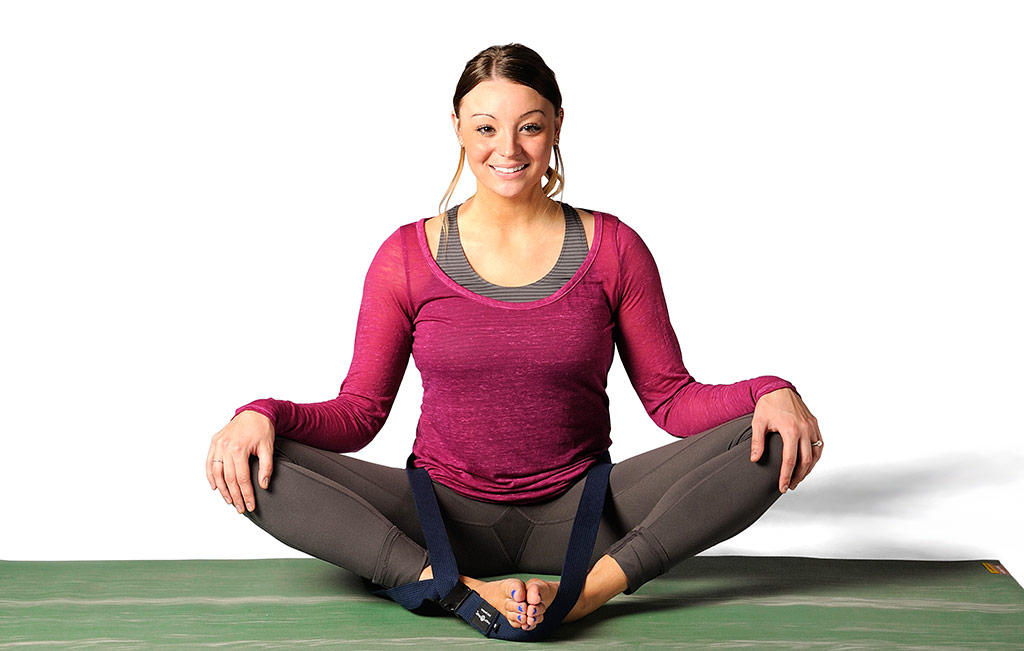
When I was in grade school, my sisters and I took ballet classes. During our brief ballet career my dad, a gymnast with an eye for form, installed a barre in our basement and led us through our ballet warm-ups every morning. None of us was diva material, but I thought the whole thing was pretty fun—the jumping around, the costumes of course, and even the warm-ups. I haven’t performed a plié in many years, but one of the exercises we practiced every day remained in my repertoire long after ballet lessons ended and before I discovered yoga in 1982: Butterfly, aka Baddha Konasana (Bound Angle Pose).
With ballet’s huge emphasis on turnout, Butterfly is one of its important warm-up exercises. More than anything, Baddha Konasana requires and develops outward rotation of the hip joints—that is, if the hip joints are shaped in such a way that outward rotation is even possible. The pose develops external rotation by stretching the adductors (the muscles that draw the leg in toward the center) and internal rotators in the groin and inner thigh. In yoga, Baddha Konasana is touted for its internal benefits.
Baddha Konasana is said to:
- stimulate the abdominal organs
- improve circulation
- soothe menstrual discomfort and sciatica
- help relieve menopause symptoms.
How to Practice Baddha Konasana
- To practice Baddha Konasana, have a few blankets handy. Sit on a folded blanket. Sitting on a blanket instead of a mat cushions your anklebones.
- Bend both knees and place the soles of your feet together, allowing the legs to release out to the sides.
- Reach back and check your lumbar spine by placing a few fingers on the spine. If your vertebrae are poking out in your low back, this means that your back is rounded (in flexion). Fold a blanket and sit on it with your pelvis on the blanket and feet on the floor. Check your spine again. If your vertebrae are still poking out, you might want to try sitting up even a little higher.
- Depending on flexibility, you may not be able to sit up high enough for your spine to draw into your back. If this is the case, place your hands behind you and use your arms to help you sit up straight. I recommend not bending forward if your vertebrae are poking out in your back, as this can stress the discs at the base of your spine.
- Another possible restriction you might encounter is discomfort in one or both of your knees. If this is the case, you can elevate your leg(s) by placing a folded blanket or yoga blocks under your thigh(s).
- You may, on the other hand, find that your legs release easily and your spine dips into your low back. If that is the case, you can practice Baddha Konasana sitting upright or you can bend forward, but only if you can initiate the forward bend by tipping your pelvic rim forward so that the pelvis and spine move together.
- Whichever variation you choose, take 5 to 10 breaths in the pose, creating space in your body as you inhale, and softening into that space on the exhalation.
Some Cautions and Considerations
There’s a common misunderstanding that Baddha Konasana is about pushing your legs down to the floor. I cringe when I remember zealous teachers 20 years ago pushing or even standing on my thighs to drive them to the floor. Fortunately, my body could take the abuse back then, and I didn’t know better. Others have not been so lucky. One friend was laid up three weeks with a snapped tendon after a teacher tried to force her legs down to the floor. So if you’re a teacher, please don’t do this!
If you push down even lightly on your thighs, you may notice that your pelvis tilts back, pushing your lumbar spine into flexion, not a healthy action for your back in this pose. Instead, think about the thighs lengthening outward from your pelvis. This is true whether your knees are millimeters from the floor or a foot above.
Speaking of which, if your knees have been way up off the floor for years in Baddha Konasana and have barely budged, it’s likely not an issue of flexibility. No two hip joints are alike. Some of our hip joints are oriented such that external rotation is really easy. Others are formed to favor inner rotation. Occasionally, someone’s hip joints accommodate both actions, but most of the time, if we rotate easily one direction, we probably won’t rotate as easily the other way. You may be part of the inward rotation camp.
So, as with all yoga asanas, please let go of the idea that your knees being high in the air in Bound Angle makes you a bad yogi. It often doesn’t even mean anything about your flexibility, let alone your strength of character. It’s all about how your hip joints are formed, and “normal” and “healthy” look different for different people.
Unlike ballet, yoga is not about performance. Like other yoga asanas, Baddha Konasana can be beneficial no matter what your pose looks like. After you spend a few breaths in the pose, stretch your legs out in front of you and feel how your body has changed. It is these moments, when we pause to let a pose integrate into our bodies and give our minds a chance to absorb what we feel, that truly define yoga practice.
Updated article from September 9, 2014.
